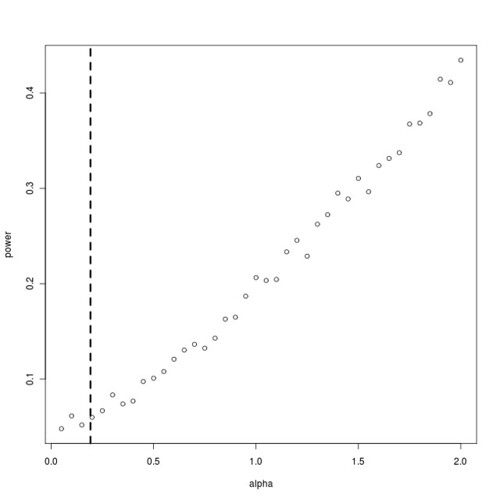Higher resolution power plot for Anoles tree
Figure (below right) shows power for increasing alpha in the Anoles tree. The vertical line shows the estimated value of alpha for the body-size data – unlikely that a tree of this size can detect selection that is this weak even if it were present. Consequently, this fit should not be taken as evidence that BM is a better fit than the OU, but rather that the data is insufficient to inform this analysis.
### The Geiger model fits
Thinking of extending bootstrap methods to work for geiger tests, i.e. can one justify the lambda transform?
Wrote anoles_ape.R in Comparative-Phylogenetics code demos, showing converting the anoles dataset for use with geiger functions. Will write a general bootstrapping that can handle the geiger models. Unfortunately the geiger model fits are not general model fit objects that can be passed to generic functions such as update and simulate. fitContinuous should return the transformed tree, the data, a class object of the fit, the call etc, and be assigned a class. Will have to get around to this later.
Note: for Anoles data, almost none of the tree transformations can improve the likelihood. Delta (exp scaling of branch length) does, just:
#### Model likelihoods for Anoles under various tree transformations
> bm$Trait1$lnl
[1] -53.66927
> ou$Trait1$lnl
[1] -53.66268
> lambda$Trait1$lnl
[1] -53.66927
> kappa$Trait1$lnl
[1] -53.66927
> delta$Trait1$lnl
[1] -53.49763
> eb$Trait1$lnl
[1] -53.64517
### Back to Writing
Reorganizing the manuscript structure … again. (draft not shown). Mapping out the outline here:
Are phylogenies Informative?
- Concerns about the model
- Concerns about the data
- phylogenetic signal
Examples from Anoles
- Why model choice BM vs OU
- Why not AIC – the overparameterized example
- Why a power test: BM vs OU
… hmm, how is it dark already? better find my bike lights and continue this later.
Adaptive Dynamics: Comparing contour plots
Meanwhile, some adaptive dynamics simulations have completed at least. Should remember to save png as higher resolution, but the bottom line seems to show substantial differences between analytic approximation and numerical simulation:
Comparing results, simulation on the left, Analytic on the right.
